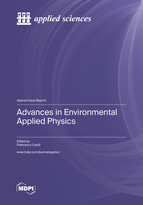Advances in Environmental Applied Physics
A special issue of Applied Sciences (ISSN 2076-3417). This special issue belongs to the section "Applied Physics General".
Deadline for manuscript submissions: closed (20 March 2023) | Viewed by 20698
Special Issue Editor
Interests: environmental radioactivity; gamma spectrometry; liquid scintillation; alpha spectrometry; gas radon detection; emanometry; ionizing radiations
Special Issues, Collections and Topics in MDPI journals
Special Issue Information
Dear Colleagues,
The presence of pollutants in the environment constitutes a health risk to the population, because it could increase the likelihood of incurring cancer. Experimental analysis will enhance the detection of significant radionuclides and metals that cause harm to the population and stimulate remediation.
Among the various analytical techniques for the assessment of physical and chemical pollutants in the environment, alpha and gamma spectrometry are employed to obtain the specific activity of alpha and gamma radionuclides, respectively; ICP-MS can be used to investigate metals concentration; liquid scintillation counting (LSC) is employed to quantify the activity concentration of tritium, radon, and gross alpha and beta; total alpha/beta counting, with the thick source method, can be used for gross alpha and beta specific activity evaluation; and emanometry, in the H2O setup configuration, can be employed to estimate the gas radon activity concentration.
Prof. Dr. Francesco Caridi
Guest Editor
Manuscript Submission Information
Manuscripts should be submitted online at www.mdpi.com by registering and logging in to this website. Once you are registered, click here to go to the submission form. Manuscripts can be submitted until the deadline. All submissions that pass pre-check are peer-reviewed. Accepted papers will be published continuously in the journal (as soon as accepted) and will be listed together on the special issue website. Research articles, review articles as well as short communications are invited. For planned papers, a title and short abstract (about 100 words) can be sent to the Editorial Office for announcement on this website.
Submitted manuscripts should not have been published previously, nor be under consideration for publication elsewhere (except conference proceedings papers). All manuscripts are thoroughly refereed through a single-blind peer-review process. A guide for authors and other relevant information for submission of manuscripts is available on the Instructions for Authors page. Applied Sciences is an international peer-reviewed open access semimonthly journal published by MDPI.
Please visit the Instructions for Authors page before submitting a manuscript. The Article Processing Charge (APC) for publication in this open access journal is 2400 CHF (Swiss Francs). Submitted papers should be well formatted and use good English. Authors may use MDPI's English editing service prior to publication or during author revisions.
Keywords
- • Environment • Radioactivity • Metals • Alpha spectrometry • Gamma spectrometry • ICP-MS • Liquid scintillation counting (LSC) • Total alpha/beta counting • Emanometry






